No more hourly and daily rates!

Consultants, IT companies, marketing agencies, and other service providers should be measured by their generated output rather than their input
In our most recent newsletter article, we discussed how artificial intelligence (AI) is revolutionizing pricing and explained how to successfully implement AI-based pricing (you can find the article here). However, AI is not only used in pricing but also plays a transformative role in our daily work as a consulting firm and in the entire professional services industry. It optimizes work processes and increases efficiency by automating manual tasks.
AI-powered tools are used in a variety of industries: they generate content and optimize advertising campaigns in marketing and advertising agencies, debug and optimize code in IT services, and automate the bookkeeping process for financial service providers. Although this list could be extended almost endlessly, all use cases have one thing in common: work becomes more efficient and the time required by humans is reduced. Currently, the adoption rate of AI technologies in the professional services sector is currently estimated at 39.1%. Forecasts predict that this share will rise to 85% by 2025 (source).
Traditionally, in the professional services industry, the value of a service is calculated based on the required time expenditure. Since services are intangible goods created by people, using daily or hourly rates initially seems logical. However, while AI technologies often reduce the time needed, the actual value of the service remains unchanged and can even increase through faster delivery or improved results. Therefore, it is time to rethink the pricing of services and redefine a comprehensive offering.
In this article, we describe how providers of professional services can find new ways to recalculate and holistically assess the value of their work within the framework of value-based monetization strategies. Finally, we provide ten practical recommendations for the successful implementation of this strategy.
Value-based monetization always requires a holistic approach and must be part of the company’s strategy
In recent years, concepts like value-based pricing, value-based selling, and value-based product have gained increasing importance, as evidenced by the large number of Google results for terms like value-based pricing, which reach over 1.3 million hits. While each of these concepts is reasonable on its own, we believe that value-based monetization must be viewed and implemented holistically. It is not enough to simply adjust pricing metrics or sales strategies; company strategies must be realigned from the perspective of the created values.
But what does “value” specifically mean in this context? We define value as the added benefit that a service provides to the customer for the price paid, whether through revenue increases, cost savings, or enhanced customer loyalty (definitions adapted from various definitions in the literature, such as the Harvard Business Review, “Value-Based Pricing” by Harry Macdivitt and Mike Wilkinson, “Preisheiten” by Hermann Simon). This definition and a holistic approach guide our methodology at hy, where we consider the dimensions of product, pricing, and selling within the framework of the Value Circle (see Figure 1). These dimensions capture the created value at different levels and constantly interact with each other.
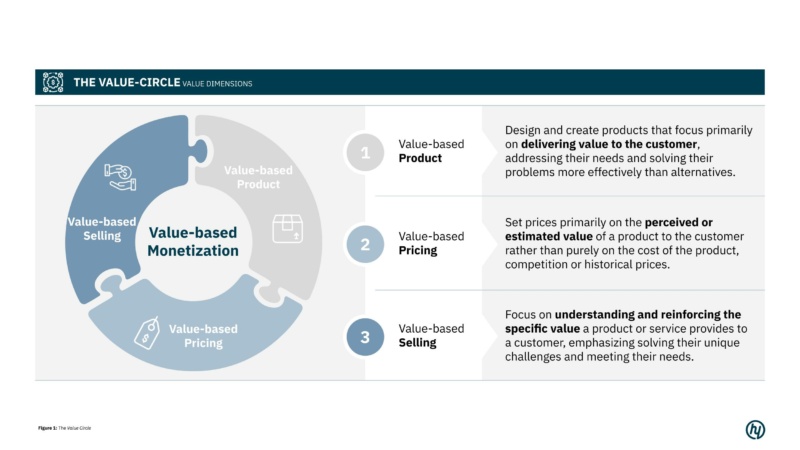
For each of the three dimensions of the Value Circle, specific value drivers, known as Value Creators, can be identified that determine the value of a service. In the following sections, we will delve deeper into each dimension of the Value Circle and explain, using selected Value Creators, the opportunities companies have to generate or better highlight value for their customers (see Figure 2).
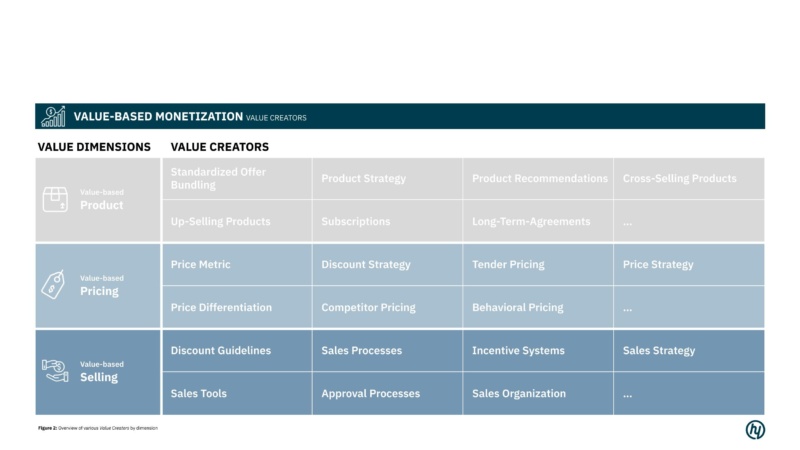
Value-based Product: Standardized solutions with clear value propositions are increasingly prevailing
At its core, the value-based product revolves around developing products and services that generate value for the customer or are perceived as valuable by the customer. To achieve this, it is crucial to thoroughly understand the customer and develop solutions tailored to its needs.
An example of this are standardized offering packages combined with a clear value proposition for each offering. By skillfully bundling products or services, holistic solutions can be developed that specifically address the customers’ unique problems. Originally known primarily from airlines, telecommunications, and software providers, the approach of combining products and features into Good-Better-Best packages is increasingly being adopted in professional services as well.

Wir bieten bereits über 40 % unserer Leistungen standardisiert an, was uns ermöglicht, unseren Kunden konsistente und qualitativ hochwertige Lösungen zu garantieren. Unser Ziel ist es, diesen Anteil auf 60-65 % zu erhöhen, während wir weiterhin die notwendige Flexibilität für individuelle Anpassungen beibehalten. Dies ermöglicht es uns, sowohl Effizienz als auch maßgeschneiderte Lösungen zu gewährleisten.Tino Beyer Geschäftsführer Communardo
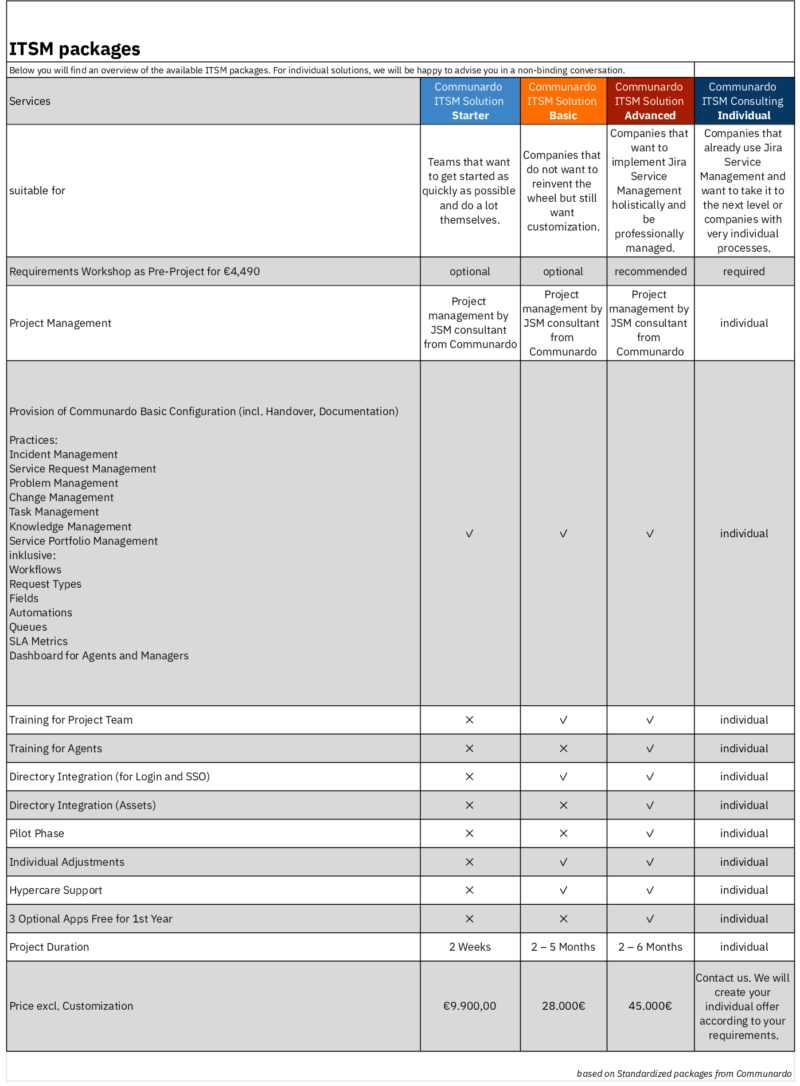
By bundling, customized offers can be developed for each customer or customer segment that align precisely with the core needs of the respective segment (see Figure 3). This approach offers significant advantages: customers benefit from comprehensive solutions instead of individual services, and sales can leverage up-selling and cross-selling potentials through well-assembled product packages. Additionally, standardization saves time in proposal creation, as the pros and cons of individual packages can be clearly communicated.
We at hy also leverage the clear advantages of this approach: in most of our project proposals, we offer different options. Multiple options provide customers with the flexibility to choose a solution that meets their individual needs and budgets while creating transparency and comparability, thereby increasing customer satisfaction and upselling opportunities. It is worthwhile to take this path to ensure long-term success for both customers and companies.
Value-based Pricing: Hourly and daily rates are billing methods of the past
As previously mentioned, pricing metrics are a central value creator in value-based pricing. Many professional services providers still bill their services on an hourly or daily rate basis.

Everyone knows that time and material as a billing mechanism will not work for much longer. With increasing efficiency through technology, it is becoming more important to consider alternative models such as fixed prices or value-based pricingDr. Jan Wildhirth Managing Director Fieldfisher X
In the past, the required working hours were a transparent and easily measurable metric for estimating the cost of a service. However, today many work steps can be automated, reducing the required work time. Therefore, it is necessary to consider which other metric could adequately reflect the value of the service.
We currently see two major trends in the market:
1. Project Pricing
Instead of billing services on an hourly or daily rate basis, more and more providers are adopting fixed prices for clearly defined projects. This offers customers transparency and planning security, as they know in advance what costs to expect. At the same time, the service provider can increase their margin through efficient work processes and automation.
In addition to the traditional billing method based on time and material, we can also offer our clients project-based pricing. While the advantage for clients lies in planning security, it allows us to increase our margins through efficient resource utilization.
2. Success-based Models
In these models, compensation is linked to the success of the service provided. One example of this is a variable revenue share in which the service provider participates in the added value achieved for the customer. These models create a win-win situation, as the service provider is directly invested in the customer’s success, and both parties benefit from positive outcomes.

At hy, we work with fixed prices and success-based models to ensure transparency and directly link our success to the success of our customers.Sebastian Herzog Co-CEO hy
Specifically, for us as a consulting firm, this means that we have not relied on daily rates for some time. Instead, we use fixed prices for a project with clearly defined project results. Additionally, we offer the option to be measured by the success of our outcomes by agreeing to variable revenue sharing in certain cases (see Figure 4; more details can be found here).
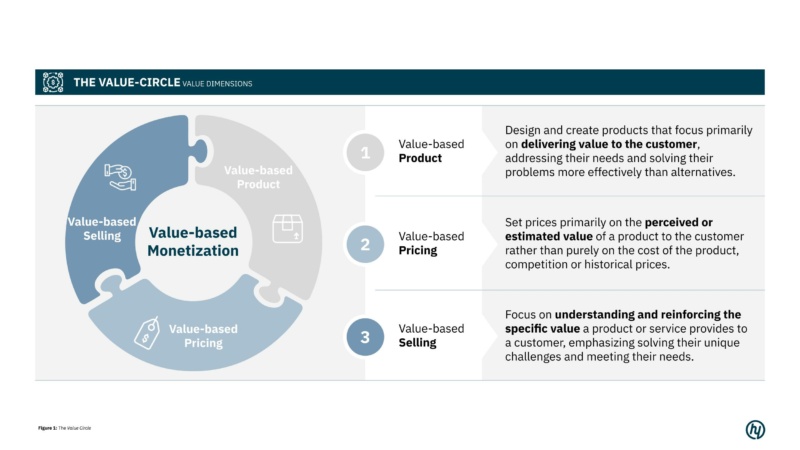
Value-based Selling: Why Multi-Factor Pricing and discount calculators are indispensable in sales
Lastly, we want to explore the dimension of value-based selling, which complements the Value Circle. Here, we take a closer look at the value creator discount policies.
Clear discount policies and a structured multi-factor pricing strategy create additional value in sales. A value-based approach takes into account the individually perceived value of the service for each customer and helps determine varying willingness to pay (see Figure 5). Prices can then be set up to the level of each customer’s willingness to pay.
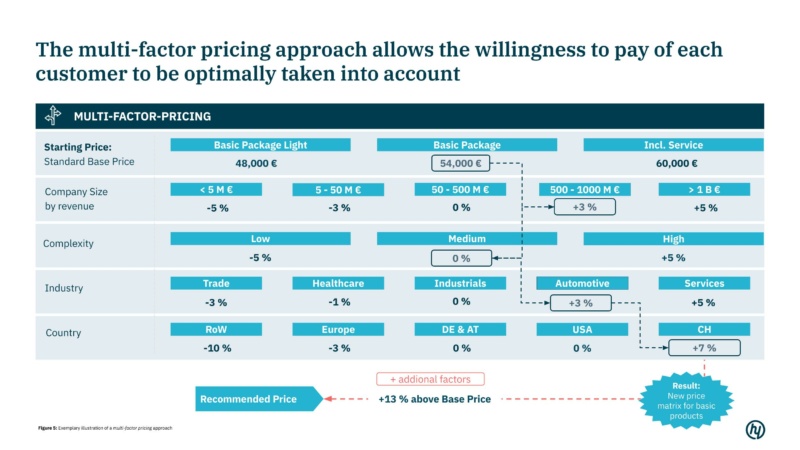
A discount calculator supports sales in implementing multi-factor pricing. It enables quick and precise calculations that consider individual customer values, competitive situations, and discount policies. This allows sales representatives to make informed and consistent pricing decisions that align with both company goals and customer needs. The calculator creates transparency in the pricing process, minimizes errors, and increases efficiency and accuracy in sales. This leads to higher revenue, increased customer satisfaction, and empowers sales representatives, thereby enhancing the overall success of the company.
From theory to practice – Helpful tips for a successful transition to Value-based Monetization
The previously shown examples demonstrate that the approaches to Value-based monetization are versatile. Therefore, it is crucial to identify the levers that will have the greatest (and quickest) impact for your company. It is important to regard this process holistically and drive the implementation of Value-based Monetization from the top level. As the Value Circle illustrates, product, pricing, and selling must be aligned and complementary to each other to achieve successful implementation.
As is often the case in strategic work, it is essential to move from planning to execution as quickly as possible. By using a lean process with a cross-functional team, the first initiatives can be implemented within a few months.
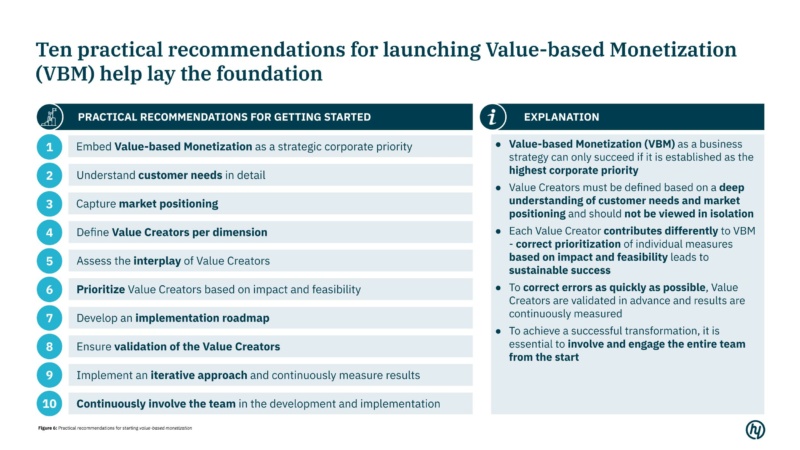
Throughout the entire process, it is crucial to involve the company’s key stakeholders. The implementation of Value-Based Monetization can only be successful when teams work together towards the defined goals. There are various pitfalls during execution. For this reason, we have compiled our 10 practical recommendations for the introduction of Value-Based Monetization (see Figure 6).
Value-based Monetization is a challenging but rewarding change process for professional services
In summary, the introduction of Value-based Monetization represents a clear paradigm shift in the professional services industry. Instead of relying solely on hourly or daily rates, companies should increasingly recognize the value they create for their customers and adopt monetization strategies that reflect this value. By focusing on the perceived benefits for the customer, service providers cannot only enhance their profitability but also build long-term customer relationships and differentiate themselves from competitors.
To successfully implement Value-based Monetization, it is crucial to understand customers’ needs, goals, and pain points and to offer tailored solutions based on this understanding. Communicating the value of the offered services also plays a key role in convincing customers of the worth of their investment. By identifying and prioritizing Value Creators along the individual Value Dimensions, professional services providers can lay the foundation for Value-based Monetization and implement it successfully over time.
Would you like to learn more about whether the introduction of Value-based Monetization is right for your company and how to implement it optimally? Contact us. We are looking forward to supporting you.

